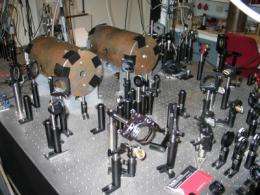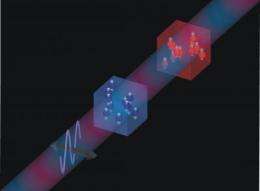Quantum memory for communication networks of the future

Researchers from the Niels Bohr Institute at the University of Copenhagen have succeeded in storing quantum information using two 'entangled' light beams. Quantum memory or information storage is a necessary element of future quantum communication networks. The new findings are published in Nature Physics.
Quantum networks will be able to protect the security of information better than the current conventional communication networks. The cornerstone of quantum communication is a phenomenon called entanglement between two quantum systems, for example, two light beams. Entanglement means that the two light beams are connected to each other, so that they have well defined common characteristics, a kind of common knowledge. A quantum state can – according to the laws of quantum mechanics, not be copied and can therefore be used to transfer data in a secure way.
In professor Eugene Polzik's research group Quantop at the Niels Bohr Institute researchers have now been able to store the two entangled light beams in two quantum memories. The research is conducted in a laboratory where a forest of mirrors and optical elements such as wave plates, beam splitters, lenses etc. are set up on a large table, sending the light around on a more than 10 meter long labyrinthine journey. Using the optical elements, the researchers control the light and regulate the size and intensity to get just the right wavelength and polarisation the light needs to have for the experiment.

The two entangled light beams are created by sending a single blue light beam through a crystal where the blue light beam is split up into two red light beams. The two red light beams are entangled, so they have a common quantum state. The quantum state itself is information.
The two light beams are sent on through the labyrinth of mirrors and optical elements and reach the two memories, which in the experiment are two glass containers filled with a gas of caesium atoms. The atoms' quantum state contains information in the form of a so-called spin, which can be either 'up' or 'down'. It can be compared with computer data, which consists of the digits 0 and 1. When the light beams pass the atoms, the quantum state is transferred from the two light beams to the two memories. The information has thus been stored as the new quantum state in the atoms.
"For the first time such a memory has been demonstrated with a very high degree of reliability. In fact, it is so good that it is impossible to obtain with conventional memory for light that is used in, for example, internet communication. This result means that a quantum network is one step closer to being a reality", explains professor Eugene Polzik.
More information: dx.doi.org/10.1038/NPHYS1819
Provided by University of Copenhagen
















